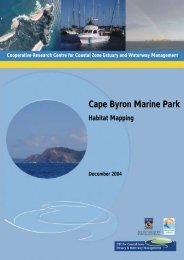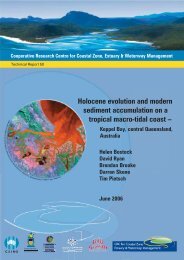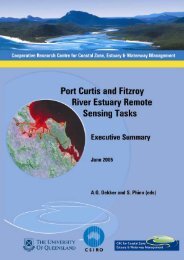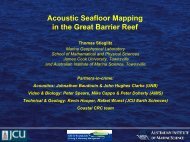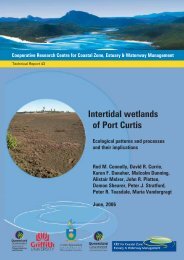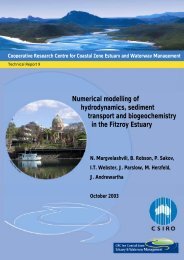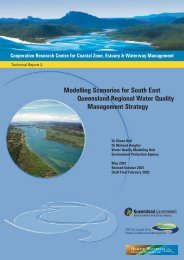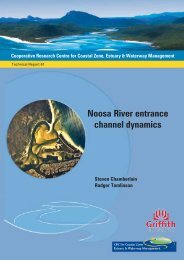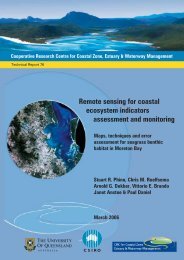The evolution of Jumpinpin Inlet - OzCoasts
The evolution of Jumpinpin Inlet - OzCoasts
The evolution of Jumpinpin Inlet - OzCoasts
You also want an ePaper? Increase the reach of your titles
YUMPU automatically turns print PDFs into web optimized ePapers that Google loves.
<strong>The</strong> <strong>evolution</strong> <strong>of</strong> <strong>Jumpinpin</strong> <strong>Inlet</strong><br />
Salter (1985) adds that alteration to currents and tides also resulted in erosion <strong>of</strong> the<br />
southern end <strong>of</strong> South Stradbroke. <strong>The</strong> author states that the greatest washout<br />
occurred in 1938, when the sea broke through at the southern point <strong>of</strong> South<br />
Stradbroke, creating an island the locals called “Tragedy Island”. In 1952 a further<br />
episode <strong>of</strong> accelerated beach erosion was observed at South Stradbroke. As reported<br />
in the Courier Mail (13.9.1952), 200 yards eroded in one month.<br />
With the onset <strong>of</strong> World War II the military began photographing the coast. Aerial<br />
photographs <strong>of</strong> <strong>Jumpinpin</strong> were found from 1944 onwards. More recent changes to<br />
<strong>Jumpinpin</strong> have been analysed from these aerials and are summarised in Chapter 8.<br />
7.3 Summary<br />
• South Passage, Southport and <strong>Jumpinpin</strong> were probably closed in 1770 as<br />
recorded by Captain Cook.<br />
• South Passage was observed open in 1799 by Flinders.<br />
• Southport observed open in 1823 by Oxley.<br />
• <strong>Jumpinpin</strong> opened either 1896 or 1898. <strong>The</strong> break divided the Isle <strong>of</strong><br />
Stradbroke into North Stradbroke (68 000 acres) and South Stradbroke<br />
(5 200 acres) islands.<br />
• Opening <strong>of</strong> <strong>Jumpinpin</strong> in the 1890s noticeably impacted the intra coastal<br />
system. Redirection <strong>of</strong> tidal flow towards <strong>Jumpinpin</strong> in the early 1900s<br />
resulted in silting <strong>of</strong> the broadwater, and erosion <strong>of</strong> the bay islands and the<br />
southern extremity <strong>of</strong> South Stradbroke Island.<br />
• It was initially thought that <strong>Jumpinpin</strong> had closed by 1917 and reopened in<br />
1936. It is concluded that an inlet did exist in 1917 to the south <strong>of</strong> the original<br />
one. <strong>The</strong> implication is that the original inlet migrated northward and closed<br />
after the second (southern) inlet breached.<br />
37





